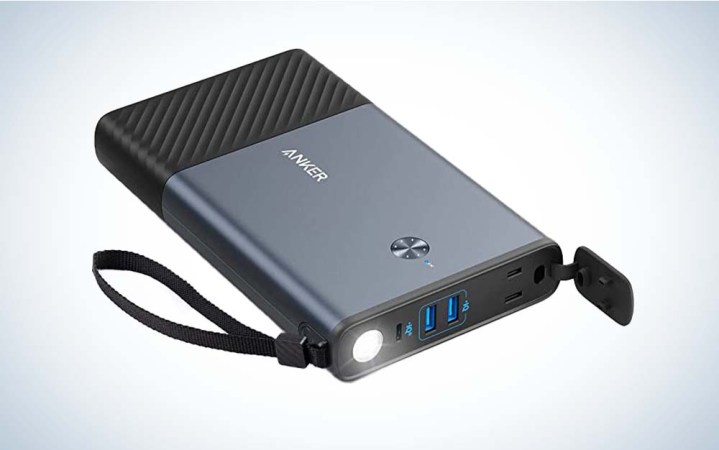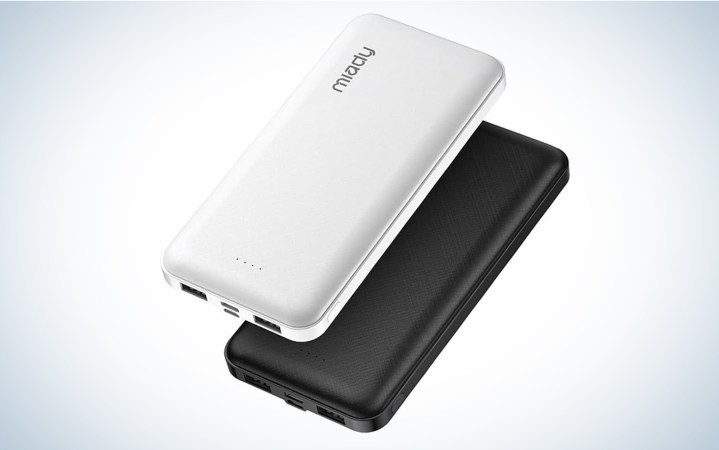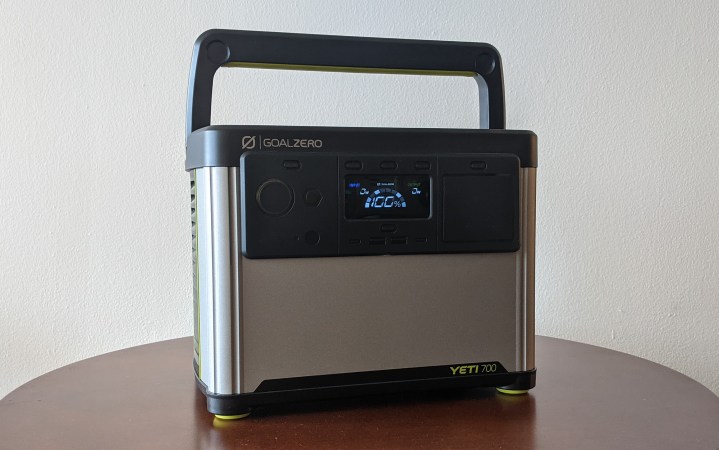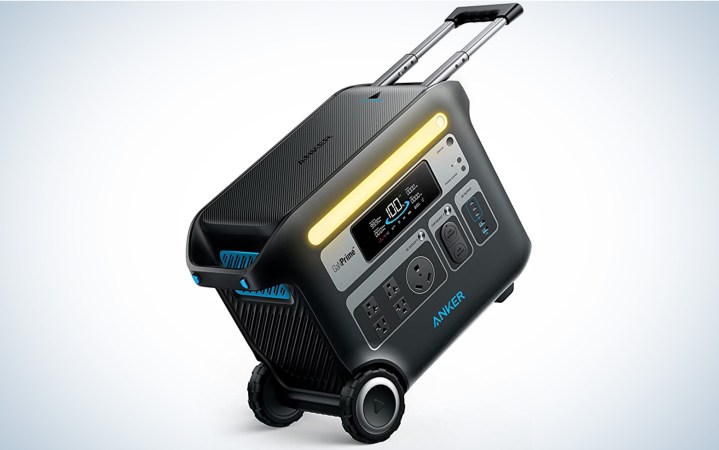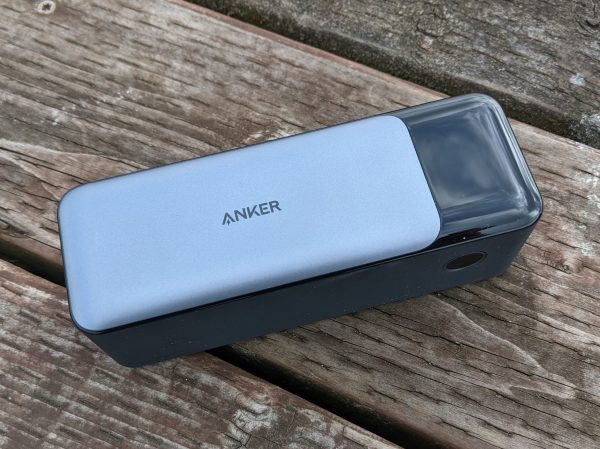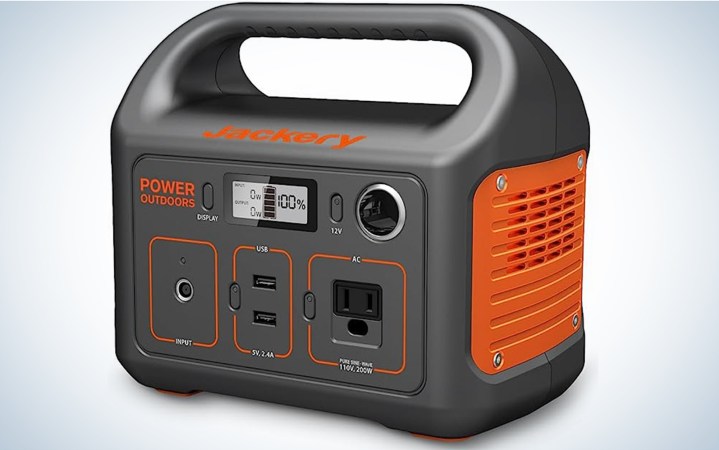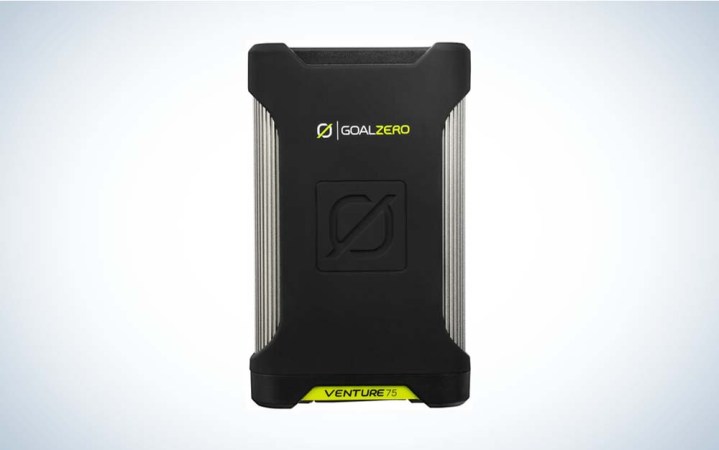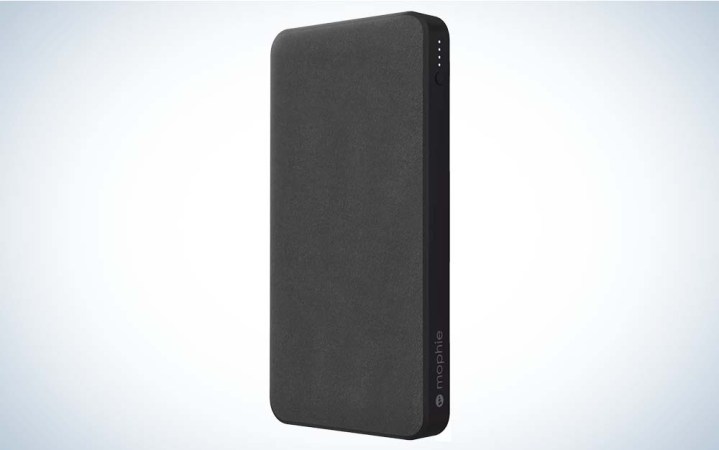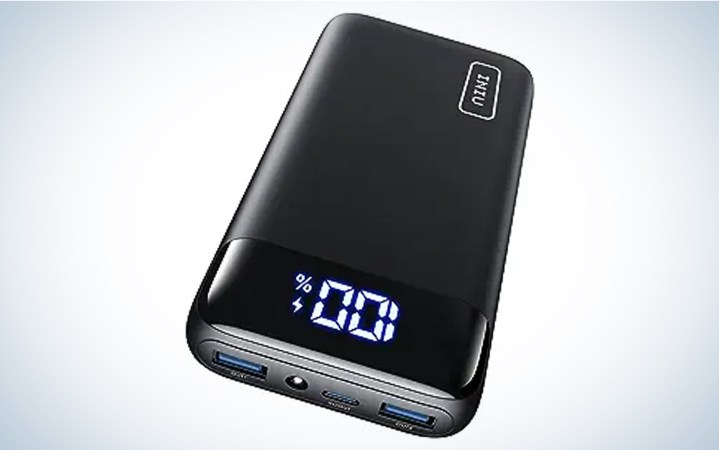The Best Power Banks for Camping of 2024
We may earn revenue from the products available on this page and participate in affiliate programs. Learn More ›
It only takes one dead phone battery to make you realize the importance of a power bank for camping. Whether it’s snapping a picture of the local flora and fauna, setting an alarm for your sunrise hike, or accessing directions for the drive home, it’s essential that you have enough juice to last to the end of your trip. To help make sure you never lose power in the outdoors again, I tested some of the best power banks for camping on the market today:
- Best Overall: Anker Powerhouse 90
- Best Small: Miady 2-Pack
- Best Large: Goal Zero Yeti 700
- Best Extra Large: Anker SOLIX F2000
- Best for Solar Generators: Bluetti AC60
- Best for Fast Charging: Anker 737 Power Bank
While the above options are my top recommendations, here are some other power banks for camping that I’ve tested and had great experiences with.
- Jackery Explorer 290
- Scosche PowerUp 32K
- GoalZero Venture 35
- BioLite Charge 40 PD
- Inui Power Bank BI-B6
How I Tested the Best Power Banks for Camping
I’ve been testing the best power banks for camping in several ways over multiple years. I’ve taken them on car camping trips, exposing them to sun and wind, with temperatures dropping down into the forties at night. I’ve used the chargers for numerous purposes, including charging my phone, charging my laptop, and charging/powering the pumps for the best camping mattresses for couples. During testing, I paid attention to which chargers I packed in my car and reached for the most often, and how long they lasted me for.
I used this experience to inform several larger tests over the last several years, including my test of the best portable power stations and my test of the best power banks for backpacking. The results of these tests have informed several of my selections below.
The Best Power Banks for Camping: Reviews & Recommendations
Best Overall: Anker Powerhouse 90
Key Features
- Weight: 1.9 pounds
- Internal battery: 27,000mAh
- Up to 100W output
- Ports: two USB-A, one USB-C, and one AC outlet
- Included cables: one USB-C to C and one USB-A to C (also includes a 45W USB-C wall charger)
- Built-in flashlight
- Warranty: 18 months
Pros
- AC outlet means this power bank can handle a wider range of devices than USB-A and USB-C ports alone
- Fast charging time with the provided wall charger
- Built-in flashlight
- About the size of a paperback book
Cons
- Display was less intuitive to use than the Scosche PowerUp 32K
There can be a fine line with power banks for camping. We’re trying to get off the grid, but we need a bit of the grid to come with us: for camping fans, air pumps, lanterns, and, of course, our phones. And when the smaller, smartphone-sized power banks stop cutting it (try sharing one of those with a loved one for more than three days), it can be tempting to upgrade to a real beast — a power bank that could maybe also serve as a home generator. Which, sometimes, can start to feel like it’s defeating the point of getting off the grid at all.
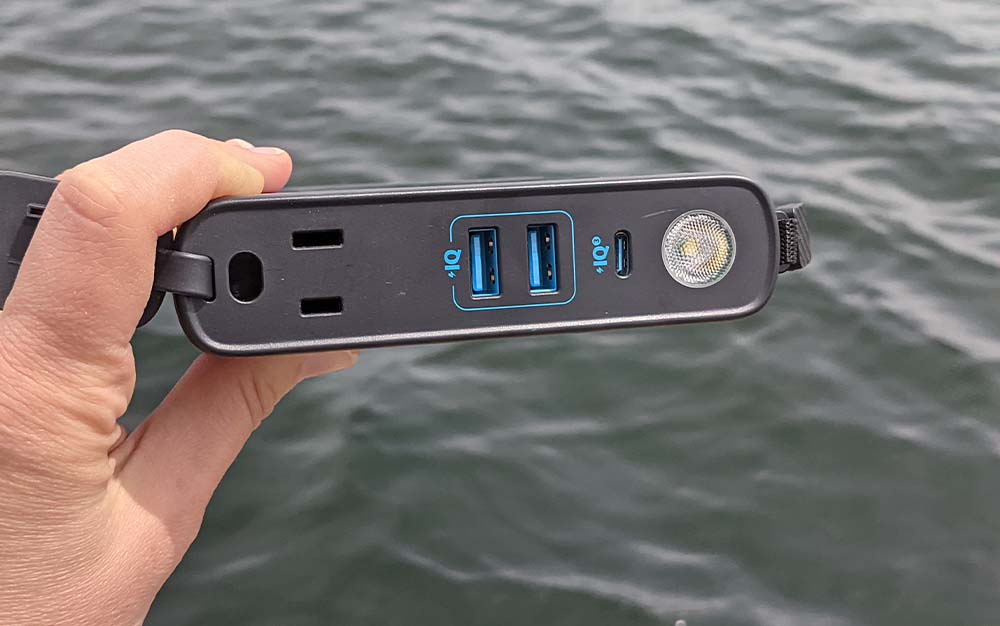
The Anker Powerhouse 90 is the perfect middle ground for your power needs. It’s got enough juice that you’ll never have to worry about your phone charge, but not enough that you’re tempted to stream all of Gray’s Anatomy when you could be sitting around the campfire. It’s big enough to include some extras, like a flashlight (handy) and an AC outlet, which was a feature I didn’t even realize I’d want until I made it to camp. But even with all that it’s still small enough that you won’t have to account for its size when fitting all your gear into your car. It would have been nice if the Anker 511 included a digital display that showed how much power it had left, rather than relying on a kicked-up version of the light bars of the smaller power banks, but it still provided the information I needed — that there was plenty of juice left in this bank for the rest of my trip.
Best Small: Miady AS-TPB21
Key Features
- Weight: 7.9 ounces
- Average Watt Hours Held During Testing: 25
- Two USB-A ports, one Micro USB port, and one USB-C port
Pros
- Very affordable
- Two for one
Cons
- Case showed signs of wear after the drop test
The lightweight Miady AS-TPB21 was not only the least expensive option I tested, it was even a two-for-one deal, making it a total steal. That’s the kind of budget option that typically proves lacking during testing. But not so with the Miady. It performed just as well, if not better, than other lightweight power banks I’ve tested at. If I had to ding the Miady AS-TPB21 on something, it’s that it is less durable. Expect some scuffing on this unit if you drop on a hard surface. Treat this one a little more gingerly, but at least you’ll have a second one on hand if it does break.
Best Large: Goal Zero Yeti 700
Key Features
- Other Available Sizes: 297 watt hours, 499 watt hours
- Weight: 20.9 pounds
- Battery Chemistry: LiFePo4
- Manufacturer Claimed Lifecycles to 80 Percent Capacity: 4,000
- Warranty: 5 years
Pros
- The most efficient unit tested for the grow light test
- Accurate control panel readings
- One of the few power stations to display the loss of power through the AC ports
Cons
- Somewhat less intuitive to use than other power stations I looked at
- The model I tested is not available in larger sizes (although other Goal Zero power stations are much, much larger)
The Goal Zero Yeti 700 was one of the most impressive units in my test of the best portable power stations and would be an excellent choice for just about any camping setup. It achieved 70 percent efficiency against its stated 677Wh size and powered a 34W grow light for over 13 hours. Unlike other units, the Goal Zero Yeti 700 also shows the power being used by the power station. To me, this is the right way to handle this: Users are more likely to wonder how much energy the power station is using to power a particular appliance than wonder how much energy the appliance itself is using. It also serves as a reminder to turn the AC outlets off when they aren’t in use, as they represent a fairly significant drain on the battery.

Laura Lancaster
The fold down handle of the Yeti 700 makes it easy to carry from car to picnic table. And I liked that a silicone flap covers the ports when not in use, protecting them from dust and other debris.
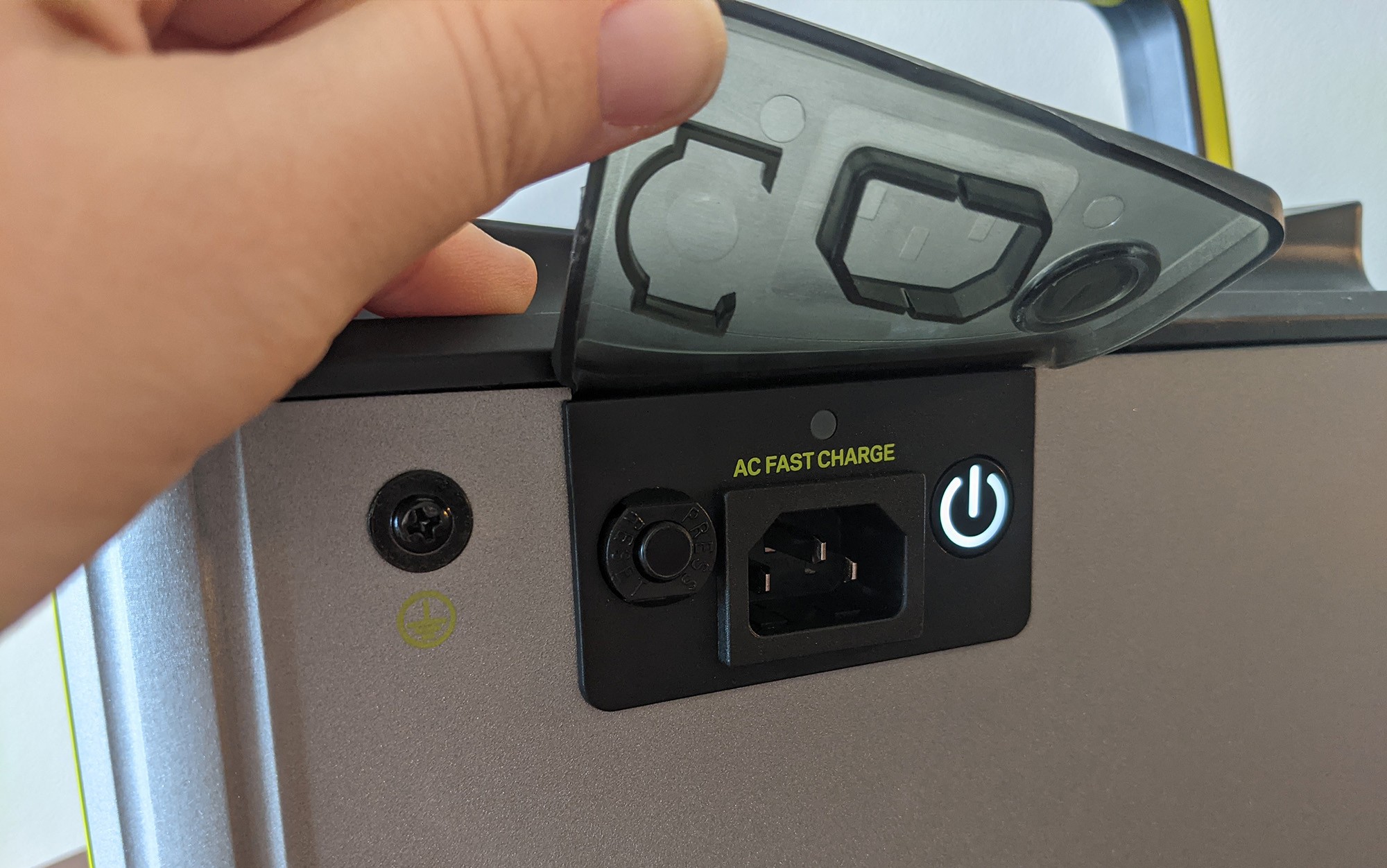
Laura Lancaster
My only gripe with this otherwise excellent unit is that it is a little less intuitive to use than the others. For instance, the power button is on the back of the unit, by the charging input port, rather than on the front.
Best Extra Large: Anker SOLIX F2000
Key Features
- Power Station Capacity: 2048 watt-hours
- Solar Panels: Two 200-watt solar panels
- 158 watts generated by one panel in direct sunlight
- Max AC Output: 120 volts and 2400 watts
Pros
- Heavy-duty wheels excel on tough terrain
- RV plug
- Fully featured app
Cons
- Heavy
- Power station tends to leach power over time
While several power stations that I’ve looked at over the years incorporated handles for ease of transport, the Anker SOLIX F2000’s were by far the most useful. It was comfortable to pull the Anker SOLIX F2000 by its handle for short distances. This included over very muddy ground during my initial test. If you regularly move your power stations more than 50 feet a time, then the ease and comfort with which you can maneuver the Anker SOLIX F2000 makes it a smart choice.
During testing, this unit was more than capable of taking on every device I could throw at it without blinking. The AC outlets alone are capable of managing 2400 watts — your average fridge is only using 250 watts or so at a time, so this is really more than enough for most purposes.
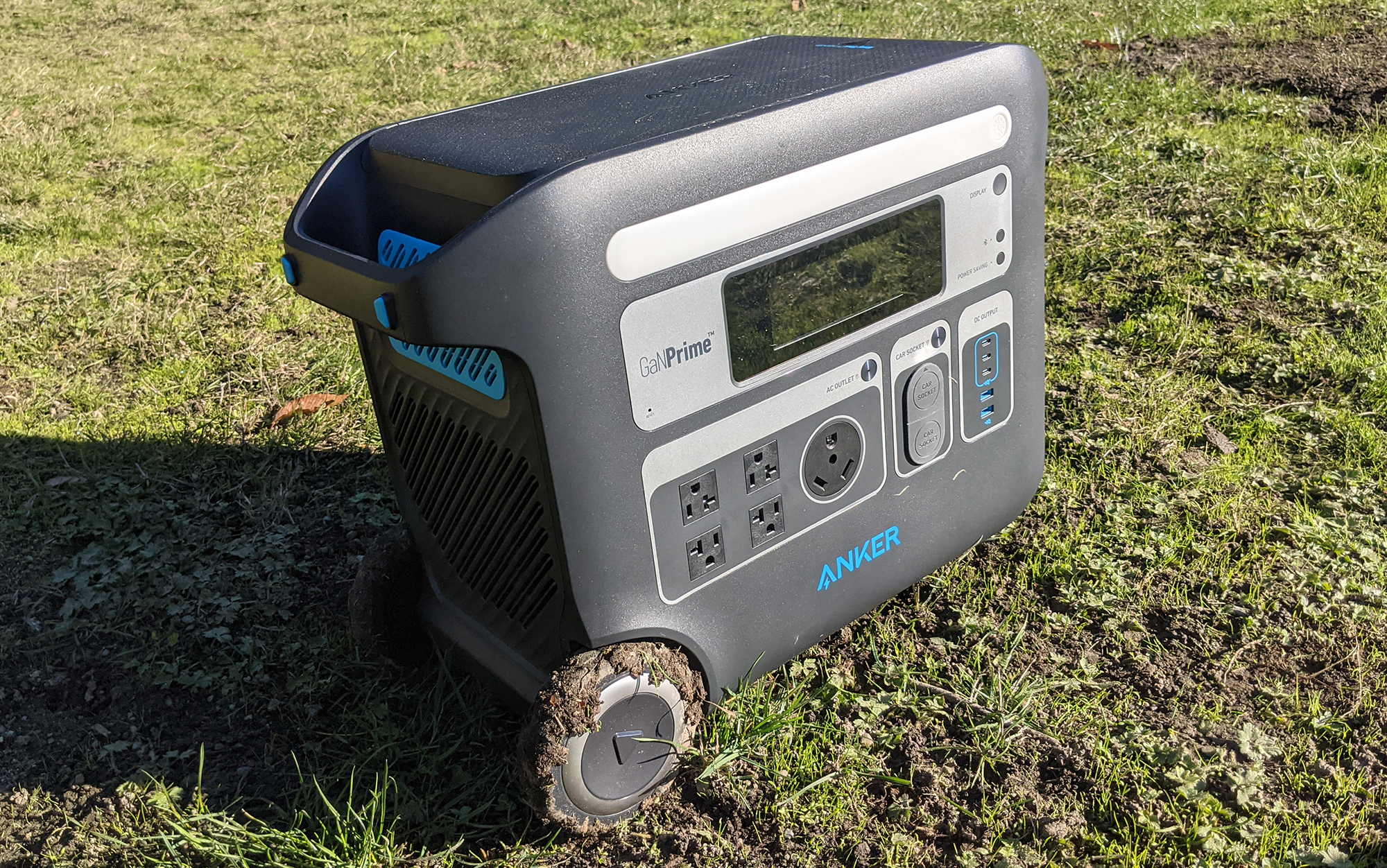
In fact, it has so much power that I didn’t come anywhere near maxing it out during testing. (Strangely, this unit only has three AC outlets compared to the six on the Anker 555 unit, which has half the watt-hour capacity.) This is also one of the few power stations on the market that comes with an RV plug, fitting, since the total capacity of the Anker SOLIX F2000 is about equal to a day’s worth of power usage by an RV.
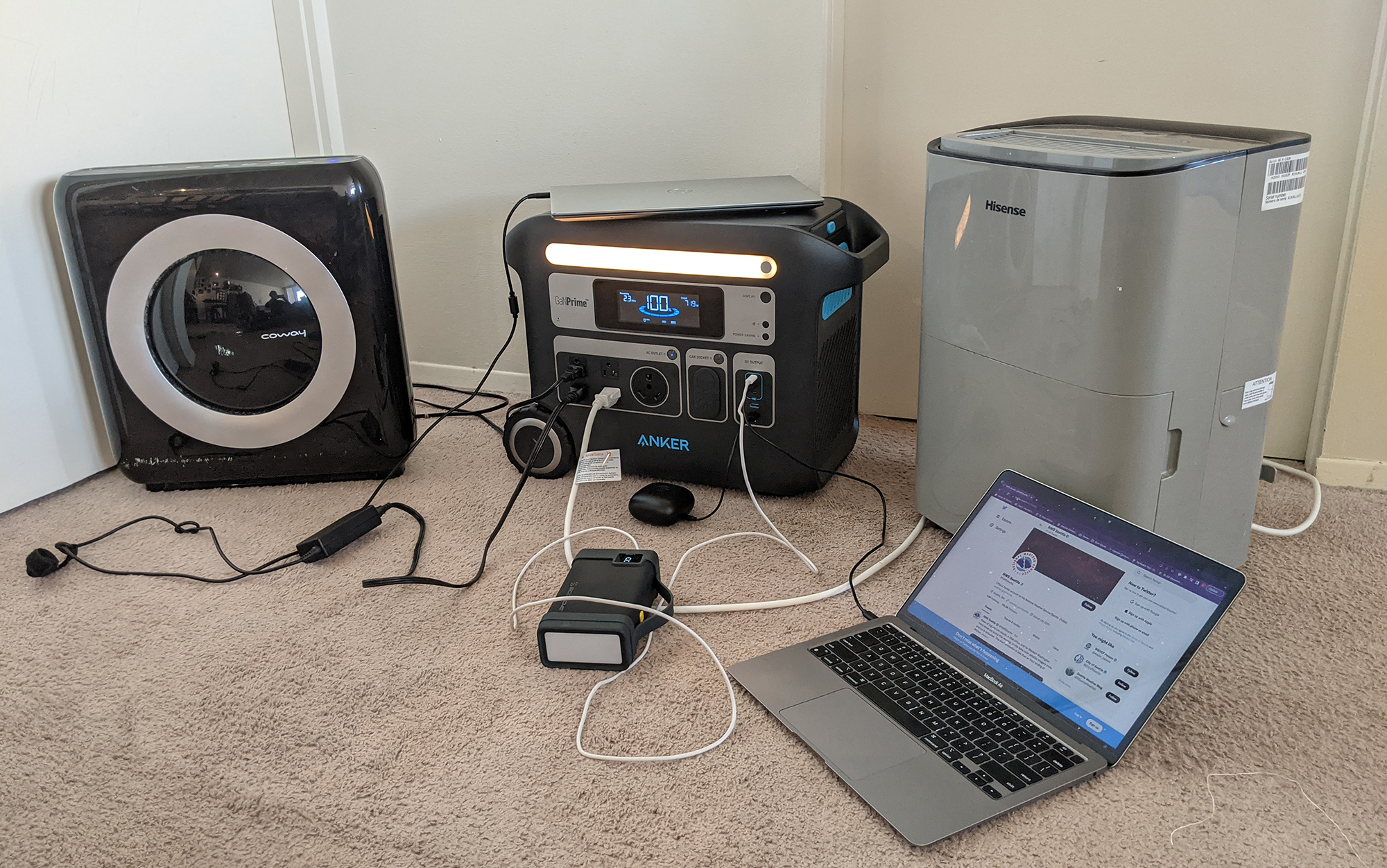
My favorite detail about this power station was the app. While testing the best solar generators, I went outside pretty often to check if everything was working properly. That gets pretty annoying after a while. But with the Anker SOLIX F2000, I could just open the app up and check to see how much power was being generated (or not). In addition to showing me the current power capacity of the unit, it also gives you the ability to turn off and on the AC, USB, and DC ports, as well as turn on the light on the side. It also shows you the internal temperature of the unit.
During ongoing testing of this unit, I observed that it is not as effective at retaining a charge long-term as other power stations in this test. I found that it lost a percentage or two of power every couple days even when not in use.
Read our full review of the Anker Solar Generator 767 for more information.
Best for Solar Generators: Bluetti AC60
Key Features
- Weight: 20 pounds
- Internal Battery: 403 watt-hours
- Max AC Output: 120 volts and 600 watts
- Ports: Two AC, USB-C, two USB-A, one car charger
- Included Cables: AC charging cable, car charging cable, solar panel charging cable
- Also available with a 800Wh expansion pack
- Warranty: 6 years
Pros
- Dust and water resistant (power station rated to IP65)
- Wireless charging potential
- Long warranty
Cons
- Functionality issues when it ran down to zero percent charge
Something you see over and over when you’re looking at the fine print on larger power stations are reminders to protect them from the elements. Rain, dirt, dust: all these can wreck havoc on the ports and inner workings of these devices. For those of us that love the outdoors and that plan to use these devices camping or overlanding, this is a bit of a conundrum.
The Bluetti AC60 is the only large power station I’ve tested that is rated to IP65. That means, when the ports are covered, it’s completely protected from dust getting inside. Just as important, it’s also able to withstand water coming at it from any direction — useful when an unexpected rainstorm hits. (Note that it’s not water resistant to the point that you can drop it in a lake.)
But even better than that is that you can easily pair this power station with the best of the solar panels for camping: the Bluetti PV120. In my testing, this panel provides the most power for the money, making it a smart choice for creating a solar generator setup.
Best for Fast Charging: Anker 737 Power Bank
Key Features
- Weight: 1.4 pounds
- Internal battery: 24,000 mAh
- Up to 140W output
- Ports: one USB-A and two USB-C
- Included cables: one USB-C to C
- Warranty: 2 years
Pros
- Fast charging
- Easy to see how much power you’re using, and what’s left
Cons
- No AC port
- Display can drain the battery quickly if left on
The more than impressive power output of the Anker 737 Power Bank combined with its best-in-class display screen made for an unusually impressive user experience. Unlike other power banks I’ve looked at, where I’m guessing at the actual power usage based on how fast the blinking lights are disappearing, this provides detailed information on each port, down to the tenth of a watt. It even provides lifetime information on the health of the battery, including the total watt hours you’ve inputted and outputted (although, strangely, it doesn’t tell you the number of watt hours left in the battery itself). The power output here is fast, too: you’ll be more limited by your available cables than you will be by your power bank (fortunately Anker provides a USB-C cable capable of delivering up to 140W of power). You may also be limited by your devices. Even plugging two laptops and a smartphone into this setup, I wasn’t coming anywhere near the 140W limit.
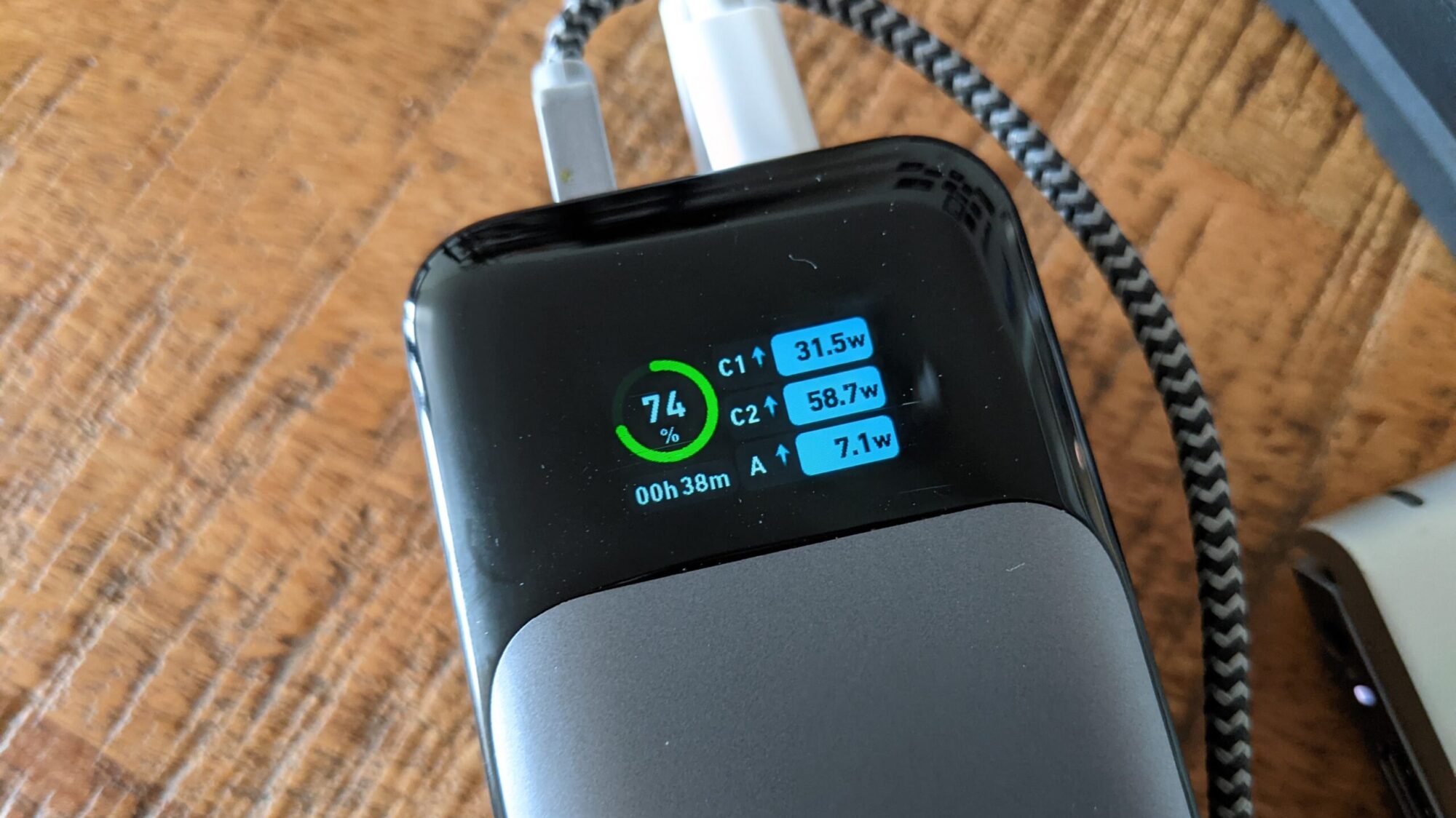
While I did not have a single device to test the 140W capabilities of the Anker 737, plugging in multiple devices that should have added up to 140W proved unsuccessful: the device wouldn’t go over 100W. No matter, that will still be plenty of power for most people’s devices and that setup will still take down a fully charged Anker 737 in less than an hour.
My only gripes with the Anker 737 are with the display. While it’s easy to read indoors, outside, even in dim light, it can be difficult to read the screen. Also, if you leave the screen on for too long (it can be set to not turn off), it will drain your battery surprisingly fast. And while I do wish the Anker 737 had an AC port, I suspect that the need for these is likely to decrease rapidly in the coming years. Possibly even enough to elevate this power bank for camping to the top slot.
Jackery Explorer 290
Key Features
- Weight: 7.5 lbs
- Internal Battery: 290Wh
- Up to 200W output (400W surge)
- Ports: Two USB-A and one AC
- Included Cables: Car charger cable, AC cable
- Warranty: 2 years
Pros
- Lightweight
- Affordable
- Pairs well with a variety of solar panels
Cons
- No USB-C port
- Difficult to charge from wall outlet if you lose the accompanying cable
This large power bank (or is it a small power station?) gets more use in my arsenal than any other. It’s small and lightweight, making it extremely portable and easy to stuff into tight corners of overpacked adventure rigs. It’s got a handy AC outlet that can handle just about any power need you’ll have in the backcountry. And it pairs well with some of the best solar panels for camping, including one of my top picks, the Anker 625 Solar Panel.
If you’ve been curious to experiment with using solar energy while out in the backcountry (as opposed to simply fully charging up a larger power station and running it down), then this combination is an excellent choice to get started. The Jackery Explorer 290 has impressed me with its ability to pull power out of different solar panels in even low-light situations, slowly charging up, a couple of watts at a time, even when the sun is low on the horizon or behind clouds.
Scosche PowerUp 32K
Key Features
- Weight: 2.2 pounds
- Internal battery: 32,000 mAh
- Up to 100W output
- Ports: two USB-A, one USB-C, and one AC outlet
- Included cables: one USB-C to C (also includes a 20W USB-C wall charger)
- Built-in flashlight
- Warranty: 1 year
Pros
- Easy-to-read display shows how much power is left
- AC outlet
- Impressive flashlight
- Easy-to-use handle
Cons
- Bulkier and more expensive than the Anker 511
- Was only able to power one device at a time during testing
The Scosche PowerUp 32K was a close second behind my best overall pick, the Anker 511 Portable Powerstation — if it had been capable of powering two devices at the same time during testing it would have come out on top. That’s because the features on the PowerUp 32K were the most impressive of any power bank in my test. First off, like the Anker 511, it had an AC outlet, which was powered by a simple on/off button that was separate from the USB on/off switch. It also has a digital display, providing an even more accurate and intuitive read of how much power was left.
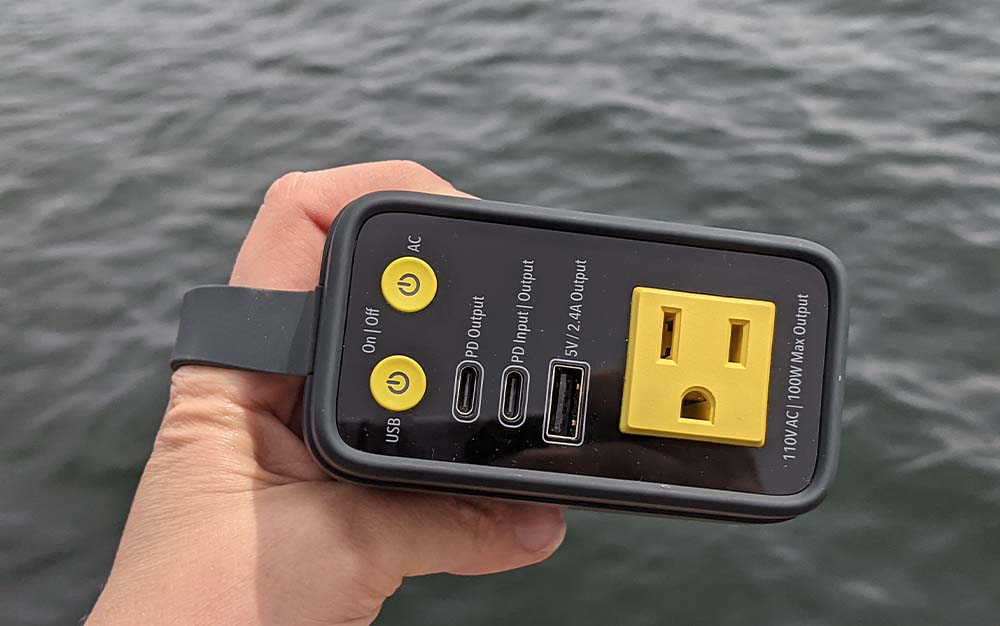
But where this power bank really stood out was its flashlight. While other products in my test looked like power banks for camping that someone had added a flashlight on to, the PowerUp 32K is more like one of the best flashlights that someone built a battery pack into — it was the brightest in my test, with a side handle that made it easy to carry while looking for my tent after dusk.
GoalZero Venture 35
Key Features
- Weight: 10.12 ounces
- Internal Battery: 9,600mAh
- Up to 18W output
- Ports: two USB-A and one USB-C
- Included Cables: one USB-C to A
- Also available as the 19,200mAh Venture 75 power bank
- Built-in flashlight
- Warranty: one year
Pros
- Very water resistant
- Small size is portable
- Fastest charge time in my test
- Includes a flashlight
Cons
- Slightly higher price than other power banks in the 10,000mAh range
- Performed third in my test of power banks in the 10,000mAh range
Most car campers will store their power bank in their car, or maybe their tent. But if you anticipate bringing yours along for a hike or having it next to you while cooking up dinner, then the GoalZero Venture 35 might be the better choice for you. In addition to its rubber housing, it also has a silicone plug that seals in the three ports and the four lights indicating how much charge is left in the power bank. I also liked that holding down the power button activated a flashlight, which is always handy when you’re making the trek to your tent after extinguishing that evening’s campfire. While this one didn’t have as much juice in it as the BioLite Charge 40 PD or Mophie Powerstation (even when taking into account its smaller internal battery), if you think there is a chance that your power banks for camping could be exposed to the elements, then this is the better pick for you. (Those concerned about battery size also have the option to level up to the 19,200mAh Venture 75).
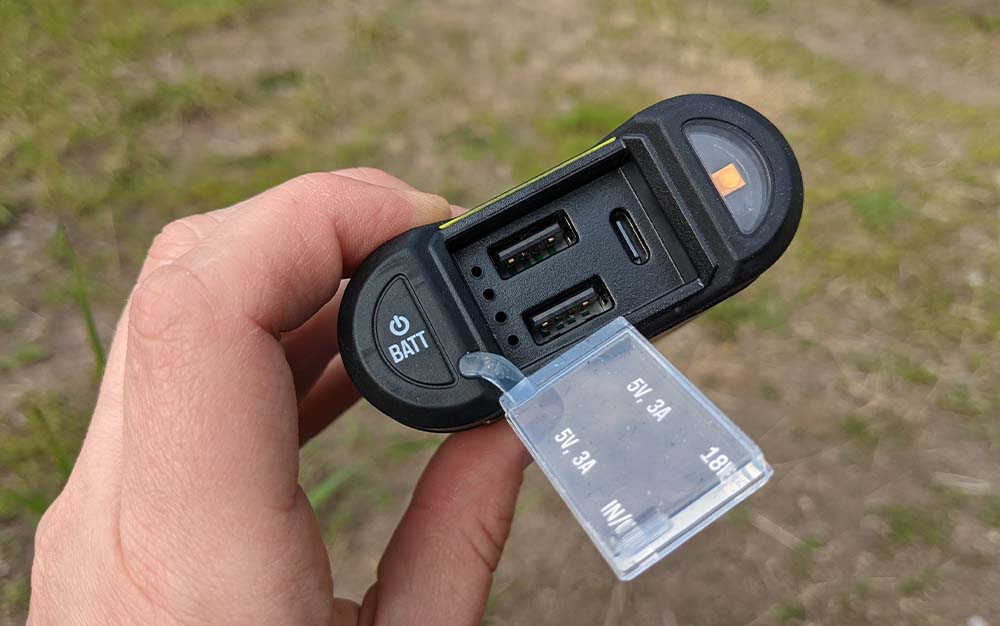
Despite the more robust bonafides of this power bank for camping, don’t be fooled into thinking it’s bombproof. The silicone plug is secured to the rest of the power bank by a relatively thin strip that, when pulled during testing, snapped and broke off fairly easily. While the casing still works even when no longer tethered to the power bank, its waterproof capabilities would be severely diminished if it was lost or left unsecured.
BioLite Charge 40 PD
Key Features
- Weight: 9.4 ounces
- Internal battery: 10,000mAh
- Up to 18W output
- Ports: two USB-A and one USB-C
- Included cables: one USB-C to A
- Also available as the 6,000mAh Charge 20 PD and the 20,000mAh Charge 80 PD
- Warranty: one year
Pros
- Provided more power than the Mophie Powerstation or Goal Zero Venture 35
- Inexpensive
- Small size means it can also be used for backpacking
Cons
- Slightly heavier (one ounce) than my best budget pick
The vast majority of car campers are using their power bank for just one thing: keeping that phone charged. And even though (at least we hope) you’re off the grid, free from the YouTube autoplay and Facebook algorithm, you’ll probably still need to use your phone for at least a couple of things. Photos. Alarm clock. Offline maps. Getting down to less than 10 percent on a camping trip can be a little stressful.
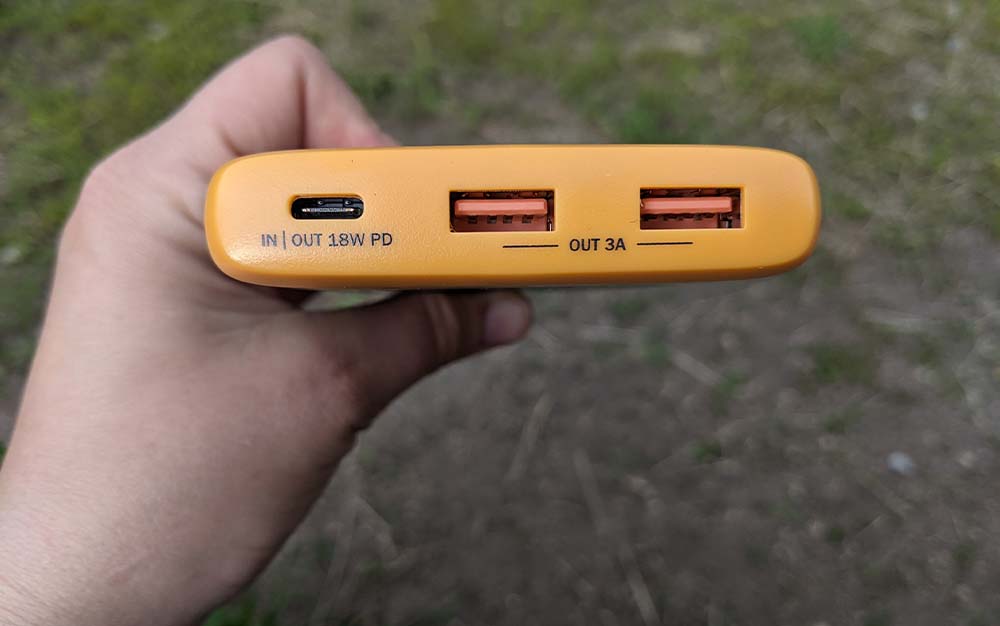
The BioLite Charge 40 PD is exactly what you need at the right price. It’ll recharge your and your camping partner’s phone (simultaneously, if necessary), it doesn’t take up a lot of space, and it’ll leave you with plenty of spare funds for the rest of your camping outfit. It’s also easy to use, with clearly labeled ports and an easy-to-read charge bar made up of four lights that blink when charging and hold steady when full.
Mophie Powerstation
Key Features
- Weight: 8.5 ounces
- Internal battery: 10,000mAh
- Up to 18W output
- Ports: one USB-A and one USB-C
- Included cables: one USB-C to A
- Also available as a 5,000mAh mini and a 20,000mAh XXL
- Warranty: 2 years
Pros
- Small size means it can also be used for backpacking
- Inexpensive
Cons
- Performed slightly below the BioLite Charge 40 PD in testing
- Only one USB-A port
If the BioLite Charge 40 PD is out of stock, then go with the Mophie Powerstation. While the Mophie charged my phone only slightly less than the BioLite, it is about an ounce lighter. More importantly, for the budget-conscious, it can also more often be found on sale.
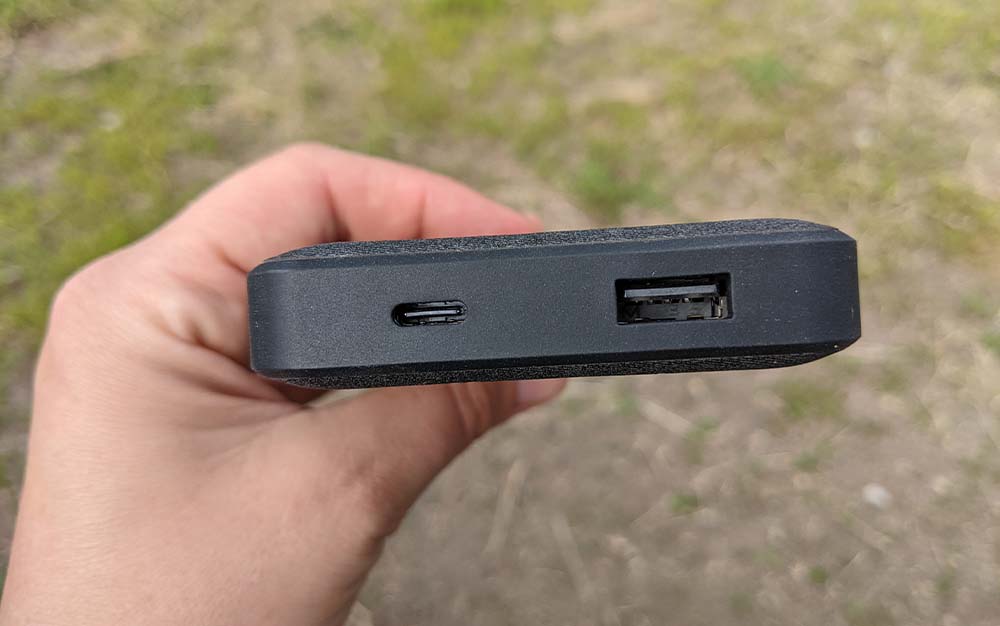
Unlike the BioLite Charge 40PD, the Mophie Powerstation only has one USB-A port, and can only charge one device at a time: during testing, when two devices were plugged into the USB-A and USB-C, neither charged. The Mophie also took significantly longer to charge during testing than the BioLite, with the final white dot blinking for hours before finally going solid.
Read Next: The Best 2 Way Radios of 2023
Inui Power Bank BI-B6
Key Features
- Weight: 7.5 ounces
- Average Watt Hours Held During Testing: 26WH
- Two USB-A ports and one USB-C port
Pros
- Better reading of how much power is left in the unit
- Held about one more watt hour than the competition
- Integrated flashlight
- Affordable
Cons
- Occasionally had trouble charging
A few blue LED lights is not a lot of information as to how much juice is left in your power bank for camping. So I appreciated that the Inui Power Bank BI-B6 showed the percent of the battery that was in use. It also had a built-in flashlight (activated by holding down the power button for several seconds), and a kickstand that can be used to prop up your phone while it’s charging. These are all nice touches that can make the experience of using power banks for camping more pleasant.
Unfortunately, I occasionally had issues with the Inui Power Bank BI-B6 when attempting to charge it. During testing, I used the USB-A to USB-C which resulted in a few instances of checking in on the power bank for camping after a few hours only to find that it hadn’t charged at all. Unplugging and replugging it in several times typically fixed the issue, but this may be a dealbreaker for some individuals.
Things to Consider Before Buying Power Banks for Camping
Battery Size of the Best Power Banks for Camping
The battery size you’ll need for your camping trip depends on the number and type of devices you’ll need to charge, how long you plan to be out for, and whether you have a way to recharge your power bank (such as a solar panel or solar generator).
Outlet Options for the Best Power Banks for Camping
If you’re just looking to charge a phone, then a USB-A outlet along with a matching cable is all you’ll need to get going. Not all power banks feature AC outlets, so if you need one for an air pump or laptop, stick with the best overall or best features picks.
Voltage of the Best Power Banks for Camping
Before purchasing a power bank, first take a look at what you’re hoping to charge during your camping trip. If you’re just looking to power a phone, you’ll need significantly less voltage, and are likely to go through fewer milliamp hours (mAh), than if you are looking to power a laptop, CPAP machine, or electric cooler.
Portability of the Best Power Banks for Camping
The power banks I tested in this roundup were chosen for their portability, as most car campers have limited space in which to store electronics in their vehicles. Since most campers’ power needs are relatively limited compared to what they go through at home, I recommend starting with a smaller power bank at first (unless you need to power a medical device) and then sizing up as you get a better understanding of your needs.
FAQs
Power banks for camping can cost anywhere from $50 to upwards of $1,000, usually depending on the size of the internal battery and the wattage they can support. Another factor that can affect price is additional features, such as waterproofing, flashlights, and electronic displays.
A spec you’ll often see is mAh, which stands for milliamps hour. The mAh spec is a measurement of power over time — the higher the mAh the more power the battery contains. To fully charge a phone you’ll need 3,000 to 5,000 mAh. There is a big price jump between 10,000mAh and 20,000mAh power banks for camping, so if you’re not sure which one you want to buy, it’s good to consider what your needs are first. Typically, a 10,000mAh battery size will provide enough juice for a couple of phone charges. If you’re heading out for a weekend — and you aren’t planning to watch a movie on your iPad — this is likely sufficient. If you’re heading somewhere out of cellphone range, one way to increase your battery life is to check that your phone is switched to airplane mode.
A power bank is a great way to charge your electronics while camping, so long as you ensure that you have the right power cords and that the voltage and size of your battery pack is sufficient for the needs of your electronics. This is especially important if you are planning to use a battery pack to power a CPAP machine at night. Many campers pair power banks with solar panels when they plan to power electronics in the outdoors for more than a long weekend.
Final Thoughts on the Best Power Banks for Camping
After testing out a number of the best power banks in a range of sizes, I’m confident that most people will get the power needs they are looking for with the Anker 511 Portable Powerstation or the Scosche PowerUp 32K. If you’re confident that you’ll just need a couple of phone recharges and nothing more, then the BioLite 40PD or Mophie Powerstation are also great choices, while you can get the same power output for only a slight increase in cost with the almost-bombproof Goal Zero Venture 35. Campers looking to power heavier duty electronics, however, should size up to the Dometic PLB40.
- Best Overall: Anker Powerhouse 90
- Best Small: Miady 2-Pack
- Best Large: Goal Zero Yeti 700
- Best Extra Large: Anker SOLIX F2000
- Best for Solar Generators: Bluetti AC60
- Best for Fast Charging: Anker 737 Power Bank
The post The Best Power Banks for Camping of 2024 appeared first on Outdoor Life.
Source: https://www.outdoorlife.com/gear/best-power-banks-for-camping/

